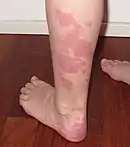Vascular malformation
A vascular malformation, is a blood vessel or lymph vessel abnormality. Vascular malformations are one of the classifications of vascular anomalies, the other grouping is vascular tumors.[2] They may cause aesthetic problems as they have a growth cycle, and can continue to grow throughout life.
| Vascular malformation | |
|---|---|
| Other names | Vascular giantism or Lymphangiomas |
| Specialty | Cardiovascular |
| Treatment | In low-flow lesions, sclerosant therapy can be extremely effective, either alone, in small lesions, or combined with surgical resection or embolization, in larger lesions. [1] |
Vascular malformations of the brain (VMBs) include those involving capillaries, and those involving the veins and arteries. Capillary malformations in the brain are known as cerebral cavernous malformations or capillary cavernous malformations (CCMs). Those involving the mix of vessels are known as cerebral arteriovenous malformations (AVMs or cAVMs). The arteriovenous type is the most common in the brain.[3]
Types
A simple division of the vascular malformations is made into low-flow and high-flow types.[2] Low-flow malformations involve a single type of blood or lymph vessel, and are known as simple vascular malformations; high-flow malformations involve an artery. There are also malformations that are of mixed-flow involving more than one type of vessel, such as an arteriovenous malformation.[2]
Low-flow vascular malformations include capillary malformations, venous malformations, and lymphatic malformations.[4]
Capillary malformation

Capillary malformations involve the capillaries, and are the most common type. They used to refer only to port-wine stains but now include others.[2] Capillary malformations are limited to the superficial layers of the skin but they can thicken, become nodular, and sometimes become disfiguring.[5] It has been proposed that the category of capillary malformations, also called vascular stains, be classified into seven major clinical types including nevus flammeus nuchae also known as nevus simplex, commonly known as stork bite or salmon patch.[6]
A capillary malformation is also a feature of the disorder macrocephaly-capillary malformation.[7]
Venous malformation
Venous malformations are typically ill-defined masses, coloured from pale to dark blue. They can affect any tissue in the body.[2] The mass is soft, and easily compressed, and their blue colouring is due to the dilated anomalous involved veins.[8] They are most commonly found in the head and neck. Venous malformations can often extend deeper from their surface appearance, reaching underlying muscle or bone. In the neck they may extend into the lining of the mouth cavity or into the salivary glands.[8]
A severe venous malformation can involve the lymph vessels as a lymphaticovenous malformation.[8]
Lymphatic malformation

Lymphatic malformations are congenital, developing from badly-formed lymphatic vessels in early embryonic development.[9] Abnormal development of the lymph vessels results in their failure to connect and drain into the venous system.[9]
These lymph vessels can become blocked due to the collection of lymph which forms a cyst as a mass, and are known as lymphangiomas. They can be macrocystic, microcystic, or a combination of the two.[9] Macrocystic have cysts greater than 2 cubic centimetres (0.12 cu in), and microcystic lymphangiomas have cysts that are smaller than 2 cubic centimetres (0.12 cu in).[10] A macrocystic lymphangioma is also known as a cystic hygroma. Cystic hygromas most often occur in the neck where they are known as nuchal hygromas.[11]
A severe venous malformation is known as a lymphaticovenous malformation that also involves the lymph vessels.[8]
Arteriovenous malformation

Arteriovenous malformations occur between an artery and a vein.
In the brain a cerebral arteriovenous malformation causes arterial blood to be directly shunted into the veins as there is an absence of a capillary bed. This carries a high risk of an intracranial hemorrhage.[12]
References
- Jackson, Ian T., et al. "Hemangiomas, vascular malformations, and lymphovenous malformations: classification and methods of treatment." Plastic and reconstructive surgery 91.7 (1993): 1216-1230.
- Steiner, JE; Drolet, BA (September 2017). "Classification of Vascular Anomalies: An Update". Seminars in Interventional Radiology. 34 (3): 225–232. doi:10.1055/s-0037-1604295. PMC 5615389. PMID 28955111.
- Leblanc, GG; Golanov, E; Awad, IA; Young, WL; Biology of Vascular Malformations of the Brain NINDS Workshop, Collaborators. (December 2009). "Biology of vascular malformations of the brain". Stroke. 40 (12): e694-702. doi:10.1161/STROKEAHA.109.563692. PMC 2810509. PMID 19834013.
- Sadick, M; Müller-Wille, R; Wildgruber, M; Wohlgemuth, WA (September 2018). "Vascular Anomalies (Part I): Classification and Diagnostics of Vascular Anomalies". Röfo. 190 (9): 825–835. doi:10.1055/a-0620-8925. PMID 29874693.
- Puttgen, KB; Pearl, M; Tekes, A; Mitchell, SE (October 2010). "Update on pediatric extracranial vascular anomalies of the head and neck". Child's Nervous System. 26 (10): 1417–33. doi:10.1007/s00381-010-1202-2. PMID 20697721. S2CID 12359248.
- Rozas-Muñoz, E; Frieden, IJ; Roé, E; Puig, L; Baselga, E (November 2016). "Vascular Stains: Proposal for a Clinical Classification to Improve Diagnosis and Management". Pediatric Dermatology. 33 (6): 570–584. doi:10.1111/pde.12939. PMID 27456075. S2CID 22474320.
- Gonzalez, ME; Burk, CJ; Barbouth, DS; Connelly, EA (May–June 2009). "Macrocephaly-capillary malformation: a report of three cases and review of the literature". Pediatric Dermatology. 26 (3): 342–6. doi:10.1111/j.1525-1470.2009.00924.x. PMID 19706101. S2CID 27334360.CS1 maint: date format (link)
- Chim, H; Drolet, B; Duffy, K; Koshima, I; Gosain, AK (August 2010). "Vascular anomalies and lymphedema". Plastic and Reconstructive Surgery. 126 (2): 55e–69e. doi:10.1097/PRS.0b013e3181df803d. PMID 20679788. S2CID 30865392.
- Elluru, RG; Balakrishnan, K; Padua, HM (August 2014). "Lymphatic malformations: diagnosis and management". Seminars in Pediatric Surgery. 23 (4): 178–85. doi:10.1053/j.sempedsurg.2014.07.002. PMID 25241095.
- "Microcystic lymphatic malformation | Genetic and Rare Diseases Information Center (GARD) – an NCATS Program". rarediseases.info.nih.gov.
- D'Souza, Donna. "Cystic hygroma | Radiology Reference Article | Radiopaedia.org". Radiopaedia.
- Mouchtouris, N; Jabbour, PM; Starke, RM; Hasan, DM; Zanaty, M; Theofanis, T; Ding, D; Tjoumakaris, SI; Dumont, AS; Ghobrial, GM; Kung, D; Rosenwasser, RH; Chalouhi, N (February 2015). "Biology of cerebral arteriovenous malformations with a focus on inflammation". Journal of Cerebral Blood Flow and Metabolism. 35 (2): 167–75. doi:10.1038/jcbfm.2014.179. PMC 4426734. PMID 25407267.
| Classification |
|---|